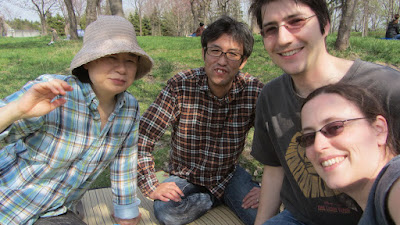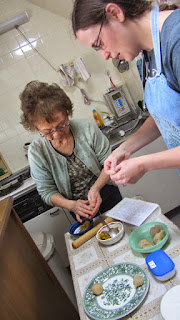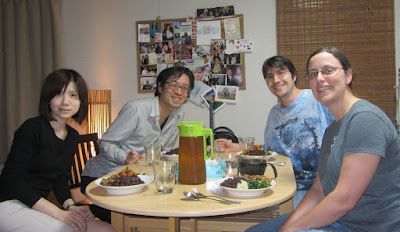Keith and Celia Olson
Newsletter #28
May 29, 2015
Dear Friends and Family,
Well, this is it. We’re down to a month left of our first term… and we have no idea how we’re going to get everything done before it’s time to get on the plane. On June 7 we have our last ministry obligation, and after that, we’ll be packing and saying our goodbyes.
We’re thankful that over the last several months, we’ve been able to do seeker Bible studies with five people--2 couples (studies led by Takahashi-sensei) and A, a high school girl (led by Celia). One of the couples, Mr. and Mrs. K, confessed faith! Praise God!
We thought (a different) Mr. K would probably start Bible study sooner or later, but not just Mr. K, but his wife as well decided to read the Bible with us… and it was (the previously mentioned) Mr. and Mrs. K who encouraged her to do so! Please continue to pray for each of these five people, that they would grow closer to God.
We are thankful for these encouragements at the end of our training. God has provided us with many opportunities at Wakaba both to observe and try different ministries, and to see God at work.
***
Some photo highlights since the last newsletter:
 |
| Movie night and chocolate workshop for the youth group |
 |
| Middle school worship band makes their debut for Sunday school |
 |
| Keith's "Koinonia" small group |
 |
| Hanami (flower viewing) picnic with Takahashi-sensei and his wife, Mina |
 |
| Concert for kids at a preschool where our friend, Noriko works |
- Please pray for our preparations for home assignment, for time with friends saying goodbye, and for handover of our responsibilities to go well. The stress keeps us from sleeping and gives us stomach aches.
- We are thankful for Tsubasa and Kyoko Saito, a couple around our age who recently transferred church membership to Wakaba. They will join the Sambi Reihai worship team and take over movie nights with the youth. Keith’s small group still needs a new leader; please pray for wisdom as to who would be a good leader for the group.
- Takahashi-sensei recently injured his knee (torn ligaments) and is recovering from surgery. Please pray for complete recovery, and that he will be able to get enough rest.
- Praise God, Mr. and Mrs. K professed faith! Please continue to pray for their continued Bible study and spiritual growth, as well as for (the other) Mr. and Mrs. K and A.
- The Wakaba Sambi Reihai team is leading worship for OMF’s 150th anniversary celebration in Sapporo on June 7. Please pray for all the details to be ironed out. Please also pray that through these anniversary events, many young Japanese will be led to serve God through missions.
- Please pray for our “re-entry” into US life with minimal reverse culture shock. This was difficult after our time as short-termers. Please pray that we will be gracious and patient.
- Discussions about our next designation continue. Please pray that God’s leading will be clear to everyone involved.
Home Assignment News
We just booked our flights to Seattle! We’ll be leaving the Sapporo area June 30, attending a conference and having a couple days of vacation for our 10th anniversary (July 9), then we will fly to Seattle July 11. We will be based in Seattle, living with Celia’s parents, until mid-May 2016.
We will spend the first month getting settled and spending time with family, and then we will be available from about mid-August for ministry and social engagements. We look forward to spending time with many of you and catching up in person! Please let us know if you would like to meet up for a meal or a coffee, or if you would like to have us share about Japan at your church, small group, Sunday school, etc.
We’ll provide more details in our next newsletter, including dates for any speaking engagements scheduled by that time.
***
Detaching
Celia and I were locking our bikes in front of our church when the pastor popped his head out the window to remind us, “You shouldn’t park your bikes over there on the sidewalk; please park them here on the church property.” I had forgotten that the church receives complaints any time the neighbors think we are taking up more space than we are allotted. I didn’t see how half a dozen bikes slightly encroaching on a rarely used part of the sidewalk could justify complaints, especially when it is only on a Sunday morning. But then again, the problem probably runs deeper, and it manifests itself in fastidiousness to the rules. Hairsplitting like this tends to frustrate me no matter where or what language, and at that moment while I was moving my bike, I confess that my frustration swayed my thoughts. I didn’t go so far as to put it into words, but I basically felt that when we finish our first term, I will be glad to get away from all this walking on eggshells.
A missionary‘s lifestyle is one of constant transition. I’ve read many books and heard several lectures describing these “settled-detaching-chaotic-resettling-settled” transition phases, but just as telling a person that he has pneumonia doesn’t make him any better, telling us that we are in the detaching phase doesn’t make it any less painful. A person in the detaching phase starts to pull up roots, focuses on finishing things, and becomes painfully aware of what he is leaving behind.
As I write this, I’m looking up at the crawling plant that has spread halfway across our ceiling during these last 2 years. I’ve sat here staring up at this plant hundreds of times while I wrestled with sermons, emails, bible studies, and especially the Japanese language. There is no way for us to keep or even to transport this plant, since it’s stuck to the ceiling. It is so much like the relationships we’ve fostered here. Two years’ worth of tea lessons, youth movie nights, worship services, prayer meetings, gardening, and 4 years of concerts, shamisen and kimono lessons, and language study. We are starting to talk to people with unspoken understanding that we may not see them again.
For good or for ill, we don’t have much time to stop and contemplate this loss in the midst of booking travel, filling out forms, packing boxes, and saying goodbye. To manage this stress, one coping mechanism we might develop in the hustle and bustle of the detaching phase is denial. Denial is focusing on the negative aspects of our life, denying the positive, and pretending that we are glad to get away from everything. Before I knew it, I had done this to the church neighbors to whom I had been trying, along with the church members, to be a light for the last two years. Perhaps looking at the negatives of my life in Ishikari would make leaving less painful, but at the same time, it would also lessen the witness of my last month here. Ending a relationship on a good note and finishing well is a very important witness in Japanese culture. Now especially is the time I need to engage with my neighbors and friends, not run away from developing deeper relationships.
We have been informed that the garden we’ve been tending for the last two years in front of this house will have a car parked on it after we move out. In an attempt to save at least some of our plants, I somberly cut down some trees, which had grown too large too close to the house, in order to make space for transplanting. As if in commiseration, it started to rain while I tied up the trees to bring to the garden waste disposal area. That was when a neighborhood grandma came out to inform me that I can’t tie up the branches with plastic rope. “But everyone else is using plastic bags. What’s wrong with plastic rope?” I argued, but she was resolute. During our conversation, the rain had intensified, so I told her I would fix it later. Stomping off back home half because of rain and half because of anger, I started to think “I will be so glad to get away from—” then I realized that I had started denying the good of living in this neighborhood and started focusing on just the negative again. So I picked up a ball of twine and went back out into the rain to retie my branches. The grandma saw me and came with her rope out into the rain too. Together we fixed it to her satisfaction. By that time, the rain had let up, and we were talking and laughing.
***
Language Corner
This is a local cement company, with the slogan, “Oops! Concrete Basics for Life.” I guess the sentiment is if you’re going to mess up, make it last.
***
Please continue to pray for us in this stressful transition time! We’re thankful for each of you.
Love in Christ,
Keith and Celia













































